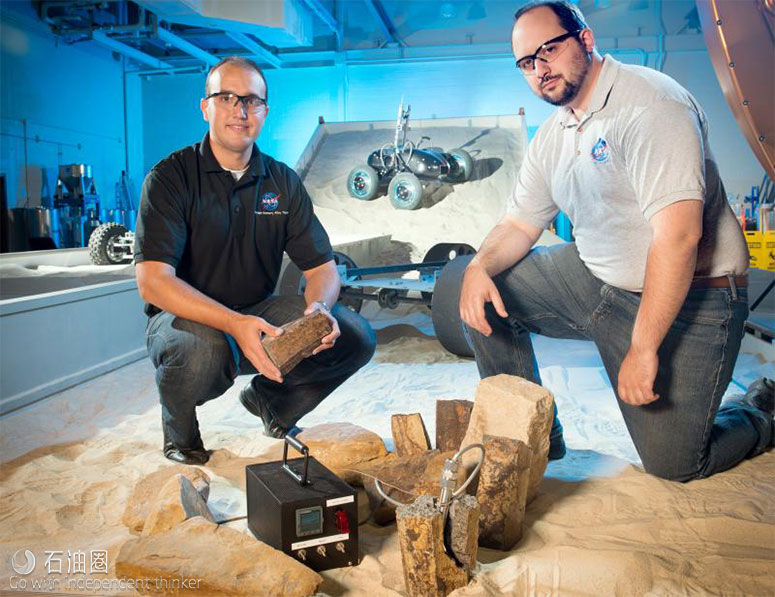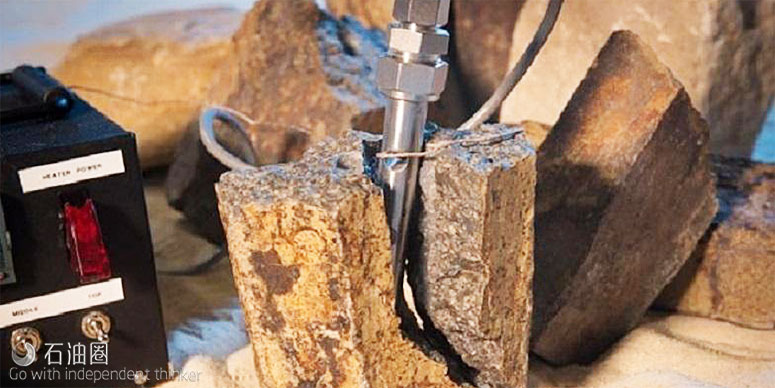The technology—known as the Shape Memory Alloy Rock Splitters (SMARS) system—provides an environmentally-friendly method for splitting apart rock formations in a controlled manner without the use of explosives or hydraulics. SMARS—a 2017 R&D 100 Award winner—has applications in hydraulic fracturing, oil drilling, mining, geological studies, civil engineering, paleontological and archaeological digs, search-and-rescue missions and more.
The innovation emerged from the research of NASA Glenn Research Center’s shape memory alloy team, which has spent more than a decade developing unique alloy formulations.
“Our team here was testing a new form of the material in the lab and it just happened that we observed that the forces were two or three times higher than any material that we had seen before,” said Othmane Benafan, PhD, a materials research engineer at NASA Glenn and one of the creators of SMARS, in an interview with R&D Magazine. “As I saw these forces being generated, I initially thought this level of force could be used for ground exploration and rock splitting on planets, like Mars and asteroids and things in space. That is how we started exploring.”
Quickly Benafan and his team realized that the innovation could be a game-changer in numerous industries beyond space that require compact, but large and static forces.
“We started asking, ‘can we generate the force that we need to break rocks and not have to carry explosives or hydraulics or other means?’ We found that we could do it by simply having a special kind of material—now known as SMA—that can do the job.”
How it works
At the core of SMARS in the SMA formulation, designed with compositions of nickel-titanium-hafnium, nickel-titanium-zirconium, or a combination of both. The design also features secondary, nanometer-sized precipitate phases achieved through chemistry control and heat treatments. These materials are then “trained” to provide the maximum force possible once heat is applied. With these materials at the center of the device, the SMARS system is capable of activating at temperatures above 100°C and generating a tremendous amount of force.
“The alloy formulation is what enables this process,” said Benafan. “In the lab, we take a rod, a piece of the material, and we do what I refer to as ‘training.’ Literally, that is what it is, we train it so that when you heat it and cool it, and it expands or contracts.”
When the SMA is later inserted into a close space, such as a drilled hole or a crack, within rock walls and heated to that actuation temperature, it exerts a larger and larger force until the rock formation breaks apart. As the SMA material cools, it reverts to its original shape, at which point the device can be used again. The SMARS system can break apart a rock formation in a very short period of time, usually less than a minute.
The SMARS system can deliver controllable stresses in excess of 1.5 gigapascals (GPa)—which is up to 100 times greater than can be generated with hydraulic systems of comparable size—without any demolition damage to the surrounding areas. In addition, the SMARS system is very small, light, and portable compared to hydraulic rock breakers, allowing it to be transported and employed in especially tight or underground settings where hydraulics equipment would have difficulty accessing. The SMA compositions in the system are also tunable to multiple activation temperatures up to 400°C, which can be especially useful in situations where more than one SMARS device is used. SMARS can also be tuned for use in cold environments (< 0°C), such as to break apart ice formations, by simply swapping the SMA compositions.
One of the biggest advantages of the SMARS system is how environmentally friendly it is, said Benafan.
“One of the biggest challenges when it comes to digging and rock fracturing is debris,” he said. “Shape memory alloys produce no debris, they are very controlled. There are no consumables, there is no oil or hydrologics or things of that sort that can leave behind damage to the site or to people. In a way there is no consumables, there is no wasted elements that go with it.”
Earth-applications of SMARS
On Earth, there are several industries where SMARS has significant potential. The oil and gas industry has a lot of interest currently, said Benafan, as oil drilling can benefit from the SMARS system’s ability to explore underground areas without causing the kind of damage often seen with demolition or chemical approaches.
“When you reach critical areas, shape memory alloys work in a very controlled fashion and there is no explosion or debris,” he said. “So you can really open up the crack and explore the wells or explore the areas where you need to dig further to see what is behind the rocks or behind the queries.”
“SMARS is also useful for areas you need to control crack,” he added. “It provides small but very, very powerful crack initiation.”
Within hydraulic fracturing—an industry that uses high-pressure pumps to inject a fluid that initiates and extends fractures in gas-bearing rock formations—SMARS could also make a big impact. The SMARS device can split rock formations in spaces where it is difficult for the pumps to operate, or to initiate fractures more precisely in targeted areas. Eliminating the use of hydraulic fluids can also greatly reduce the environmental impact of the fracturing process.
Another area of particular interest for SMARS is search and rescue, where SMARS and be used to move debris. In a situation where people are trapped by debris from a collapsed building or a rockslide, the SMARS device’s portability allows it to be put into action quickly, and the system can effect displacement without further endangering trapped victims.
“Currently they either have to have a lot of people or equipment such as big cranes to do this job,” said Benafan. “Imagine if you have SMARS technology, and just like you could use it to break rocks, you could use it to free something away, whether you are lifting away a column to free a human being, or to open a jammed door.”
SMARS in space
Benafan’s initial idea of using SMARS in space is also still a top priority, but there are technical challenges to make it a reality. Rock size in space is one barrier.
“We have shown that if we have a rock that is 30 pounds we can break it, but now we are trying to see what we need to do with SMARS technology to break a 300 pound rock and be able to manage that amount of load,” he said. “Do we use five SMARS in series or five SMARS in parallel, or do we need some other concept in there to be able to tackle that. That question needs to be answered before we could use it for a space mission, whether it’s Mars or for asteroids or something else.”
Next steps
Interest in SMARS is growing swiftly. Currently NASA is working with several industry partners within the oil and gas industry that want to utilize the SMARS technology.
“After we reported on its capabilities, and, of course, after the R&D 100 Award, people have noticed that this technology really works for a number of aspects, and that is actually what drew this interest from collaborators within the industry to come and use SMARS,” said Benafan.
“We are in the process of working with them to build prototypes, trying to direct SMARS toward an application-specific environment. But we are still using the same concept, the same material, the same force requirements as we initially had demonstrated with our SMARS technology.”

 石油圈
石油圈


